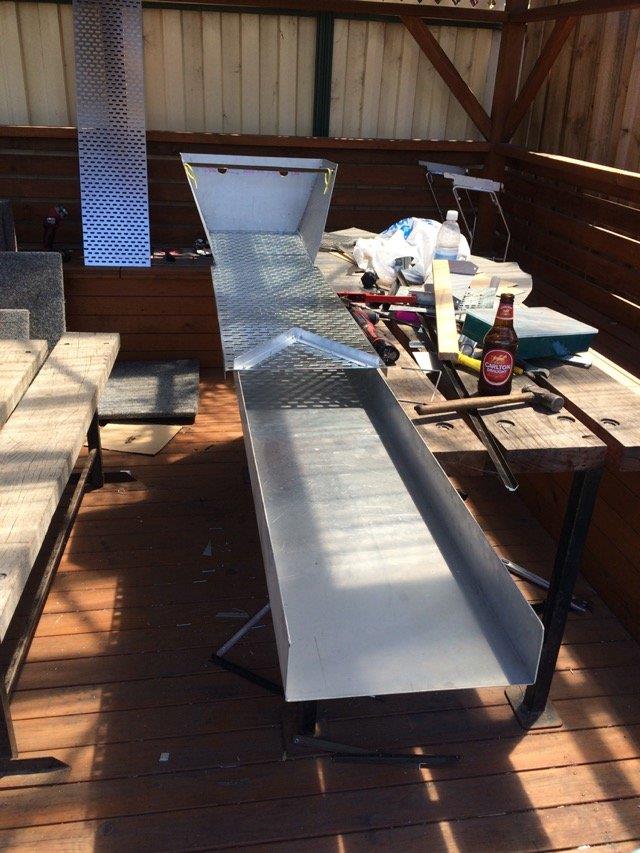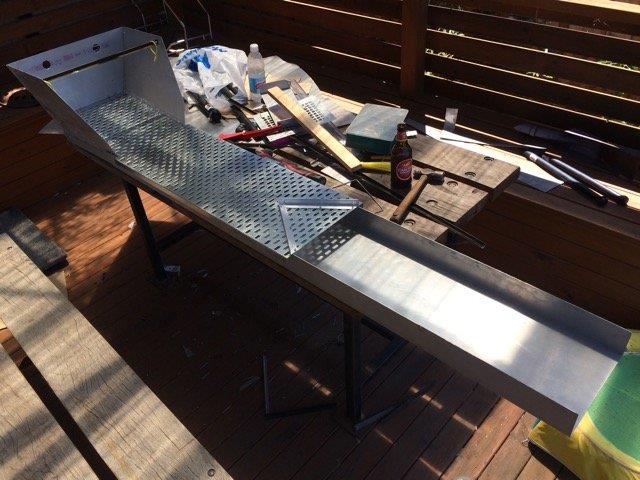You are using an out of date browser. It may not display this or other websites correctly.
You should upgrade or use an alternative browser.
You should upgrade or use an alternative browser.
Pumps for a Highbanker - information and questions
- Thread starter Prospector steve
- Start date

Help Support Prospecting Australia:
This site may earn a commission from merchant affiliate
links, including eBay, Amazon, and others.
DirtyBob
Robert
Hi Jeff
Did you end up buying the pump? Would be interested to know how it's going.
Did you end up buying the pump? Would be interested to know how it's going.
DirtyBob
Robert
Thanks Jeff
Thinking it will be good enough to get me started and hard to argue with the price.
Looks like I have my Father's Day present.
Thinking it will be good enough to get me started and hard to argue with the price.
Looks like I have my Father's Day present.
G
Guest
What Type of Pump Do I Need? This would have to be the most asked question I have heard over the years and it would be the most difficult one to answer. These are my thoughts on pumps and pump size. I know this topic has already been talked about but I still find it interesting. So lets kick the can a bit more on the subject.
Ask yourself this before buying a pump.
1. Where will you be using the pump local or traveling?
2. If you are local at what distance will you be pumping?
3. Traveling you could be working at any type of distance?
4. What type of unit & jetting will the pump be required to run?
5. The pump needs to be economical to run.
Jetting size and type, unit size, pumping distance and pump weight are the key factors for your new pump selection in fact I think all of the above are important. If I were going to buy a new pump I would first take into consideration what type of unit I am running and that I will be traveling, the type of ground I will be encountering, also I will not know my pumping distance. So I would be looking at a 4 stroke 2.2 or 2.5 hp {this also eliminates the need to mix fuel}. I would set my pumping limit to 100 meters {at this distance I can carry all my lay flat pump and camping gear}. Around creeks at the most you would be looking at pumping 50 meters I would be surprised if you would needed to pump that far but you never know. Remember this if you have to walk in and find the walk hard going, it will be 3 times harder coming out.
As best I know and up to a distance of 60 meters the little Oleo-Mac SA18 2 stroke weight 3kg can do a good a job, almost as good as a Honda WX15. How I know this is I run both types of pumps at different times. Consideration of all the mentioned points must be given, and then make your purchases from there. You must also make sure you are getting what is advertised. Request the flow chart for the pump as well { brand names only will supply a chart }this will give the flow rate & head over distance it is very important to get this information.
Hoses!
Whats important to know about a hose, you hook them up when starting work then roll them up when completed! Thats true but there is a bit in between we must look at.
Point 1, what would you do if you dropped a rock on your lay flat and holed it? You would take the fitting of the hose cut a length from the lay flat around 6 inches long, mark the hole then slide the length of 6 inch lay flat you cut off over the damaged lay flat to the hole covering the hole with at least 3 inches either side. Note you can fix a hose in this manner no matter how severely damaged it is.
Point 2, say you have run out all your hose which had fittings attached, but you were still 20 feet short of your work area. But you have other lengths with you and have no fittings for them. This is what you can do, it is a bit tricky at the start but it will work. At the last length of lay flat from the pump remove the fitting run out the new bit of lay flat which will cover the distance required to reach the work area. Go back to the lay flat you removed the fitting from. And slide the lay flat from the pump into the new bit of lay flat you just run out, you may need to slide it in around 3 feet. The fitting you removed from this end you place on the end of the lay flat at the work area. Then hook up the hose to your plant for this to work you must have pressure. It is this pressure that will expand the hoses and hold them in place.
Point 3. Your pumps pick up hose should be smooth boar on the inside, it is very, very important that this hose dose not suck air. If it dose you will notice the difference in your pumps performance big time.
Well there you go they are my thoughts along with a bit of trouble I encountered and how I worked out how to fix them, I hope it can help.
Ask yourself this before buying a pump.
1. Where will you be using the pump local or traveling?
2. If you are local at what distance will you be pumping?
3. Traveling you could be working at any type of distance?
4. What type of unit & jetting will the pump be required to run?
5. The pump needs to be economical to run.
Jetting size and type, unit size, pumping distance and pump weight are the key factors for your new pump selection in fact I think all of the above are important. If I were going to buy a new pump I would first take into consideration what type of unit I am running and that I will be traveling, the type of ground I will be encountering, also I will not know my pumping distance. So I would be looking at a 4 stroke 2.2 or 2.5 hp {this also eliminates the need to mix fuel}. I would set my pumping limit to 100 meters {at this distance I can carry all my lay flat pump and camping gear}. Around creeks at the most you would be looking at pumping 50 meters I would be surprised if you would needed to pump that far but you never know. Remember this if you have to walk in and find the walk hard going, it will be 3 times harder coming out.
As best I know and up to a distance of 60 meters the little Oleo-Mac SA18 2 stroke weight 3kg can do a good a job, almost as good as a Honda WX15. How I know this is I run both types of pumps at different times. Consideration of all the mentioned points must be given, and then make your purchases from there. You must also make sure you are getting what is advertised. Request the flow chart for the pump as well { brand names only will supply a chart }this will give the flow rate & head over distance it is very important to get this information.
Hoses!
Whats important to know about a hose, you hook them up when starting work then roll them up when completed! Thats true but there is a bit in between we must look at.
Point 1, what would you do if you dropped a rock on your lay flat and holed it? You would take the fitting of the hose cut a length from the lay flat around 6 inches long, mark the hole then slide the length of 6 inch lay flat you cut off over the damaged lay flat to the hole covering the hole with at least 3 inches either side. Note you can fix a hose in this manner no matter how severely damaged it is.
Point 2, say you have run out all your hose which had fittings attached, but you were still 20 feet short of your work area. But you have other lengths with you and have no fittings for them. This is what you can do, it is a bit tricky at the start but it will work. At the last length of lay flat from the pump remove the fitting run out the new bit of lay flat which will cover the distance required to reach the work area. Go back to the lay flat you removed the fitting from. And slide the lay flat from the pump into the new bit of lay flat you just run out, you may need to slide it in around 3 feet. The fitting you removed from this end you place on the end of the lay flat at the work area. Then hook up the hose to your plant for this to work you must have pressure. It is this pressure that will expand the hoses and hold them in place.
Point 3. Your pumps pick up hose should be smooth boar on the inside, it is very, very important that this hose dose not suck air. If it dose you will notice the difference in your pumps performance big time.
Well there you go they are my thoughts along with a bit of trouble I encountered and how I worked out how to fix them, I hope it can help.
G
Guest
Here are a few photos that explain the hose patch. The water expands the lay flat which in turn holds the patch in place. Its a good trick to remember.
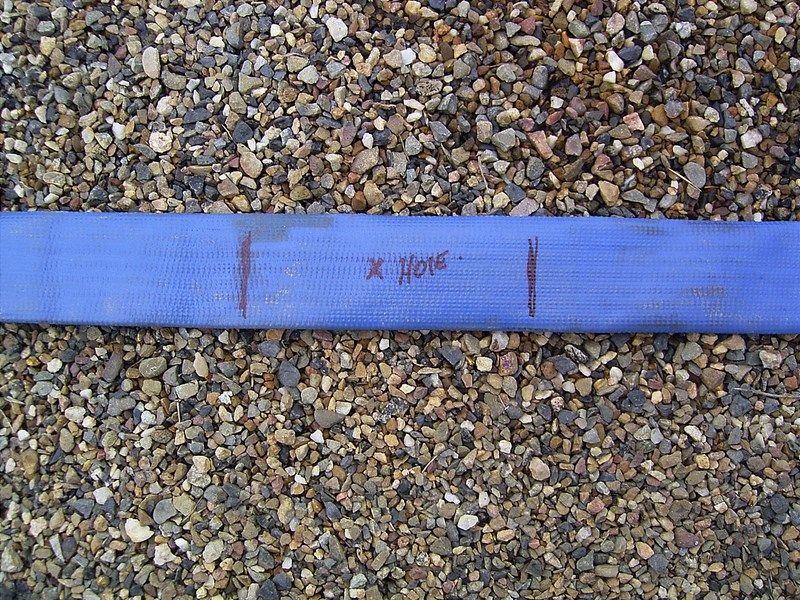
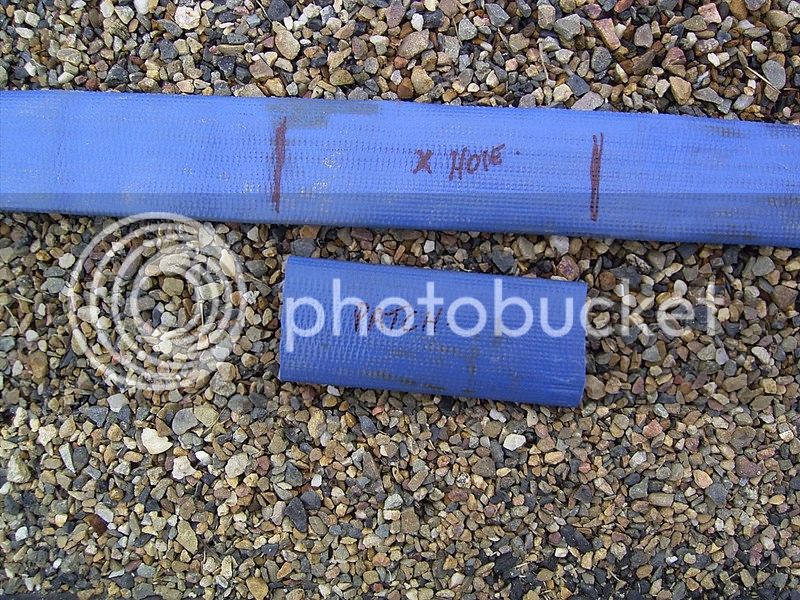
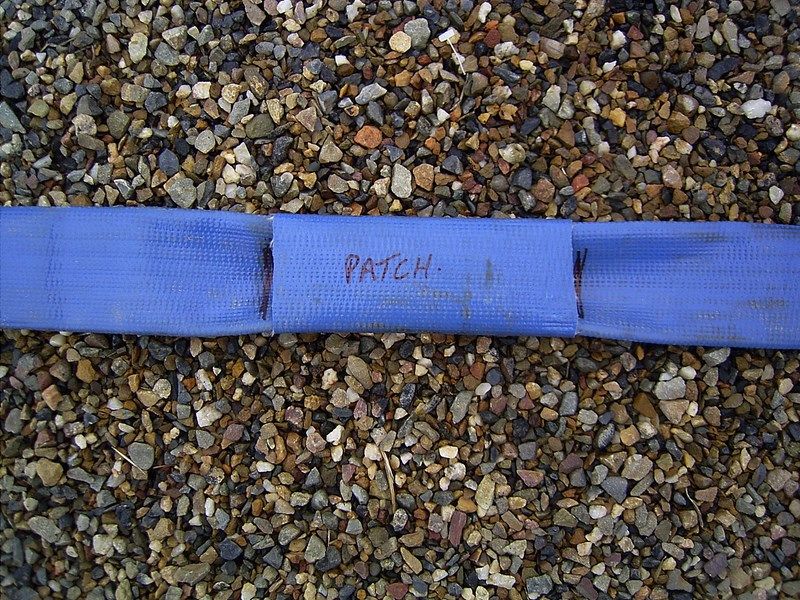



always a good topic for new players... i'll add my two bob
tell you the truth i always have gone with bigger is better and most people cant believe i carry such a big pump so far but i have to tell you water on demand is nice, pressure is fantastic and being able to run all weekend without adding fuel makes my prospecting a little greener.
I'm running a Honda gx200 6.5hp with a p180 pump puts out up to 68000 litres per hour or 1135 pm with a head pressure of 180 feet so finding a water source and pumping up a gully to the gold is very easy.
I do have several pumps in smaller size but i dont tend to use them because they are too noisy or i have to fill them too often.
with regard to hose well hose aint hose... great lesson there jembaicumene in patching hoses, there really is no other way to repair that will hold long term other than the example above.
If you can afford it go red, seriously blue hose is not designed to be bumped and vibrate along rocks and it wont last get braid or at least red hose. cant tell you how much blue hose ive cut and mended in the past.
Since buying only red hose ive never seen even a pin whole, with the red braid the upside it rolls to half the footprint of rubber hose.
this stuff is the good rubber hose it doesn't tear easily and ive actually seen a car towed out of the mud with one of these doubled over
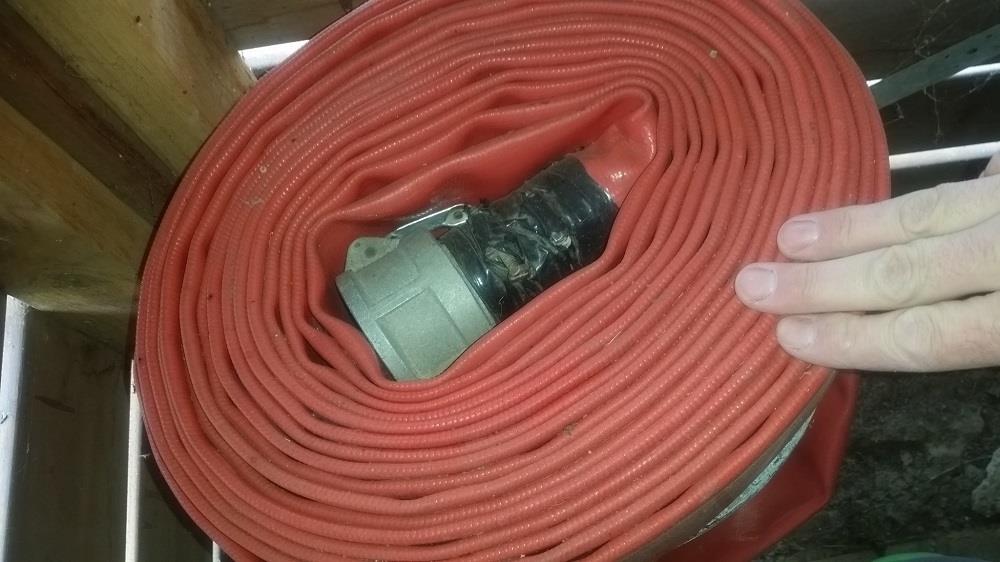
if you cna get hold of this braid this is the best hands down hose ive ever come across, when wound like this 25 meters is actually smaller than 15 meters of red lay flat. size wise it fits nicely in a milkcrate.
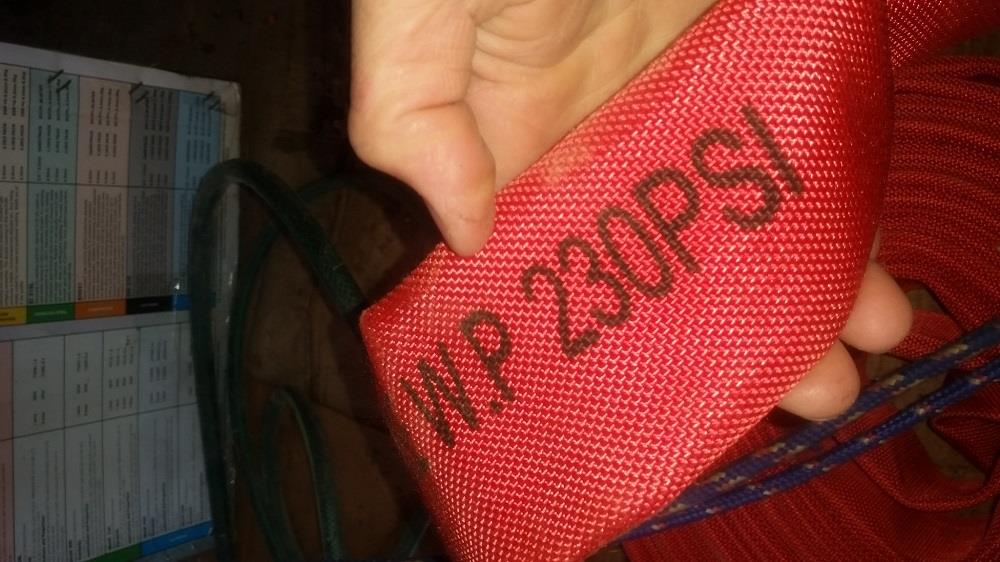
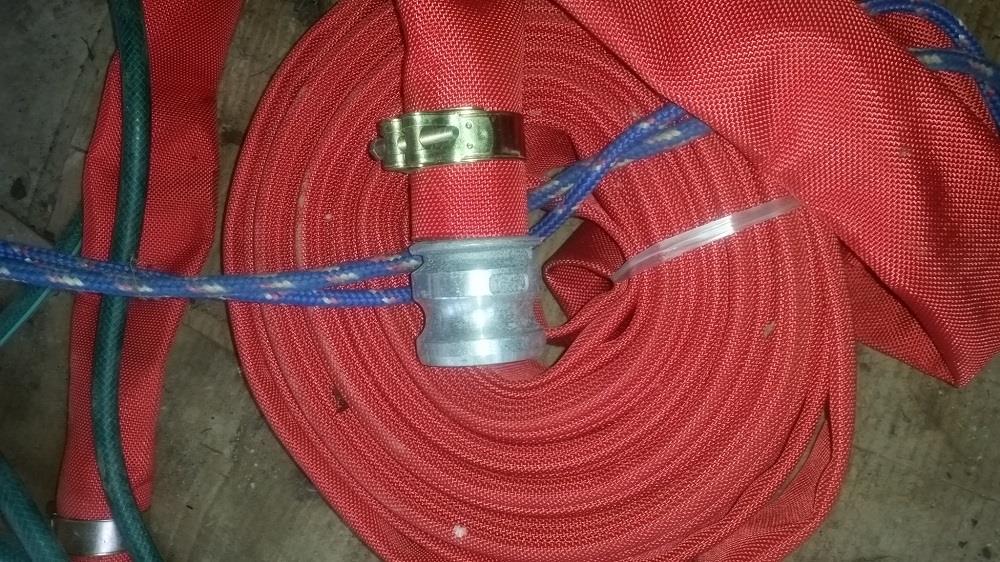
tell you the truth i always have gone with bigger is better and most people cant believe i carry such a big pump so far but i have to tell you water on demand is nice, pressure is fantastic and being able to run all weekend without adding fuel makes my prospecting a little greener.
I'm running a Honda gx200 6.5hp with a p180 pump puts out up to 68000 litres per hour or 1135 pm with a head pressure of 180 feet so finding a water source and pumping up a gully to the gold is very easy.
I do have several pumps in smaller size but i dont tend to use them because they are too noisy or i have to fill them too often.
with regard to hose well hose aint hose... great lesson there jembaicumene in patching hoses, there really is no other way to repair that will hold long term other than the example above.
If you can afford it go red, seriously blue hose is not designed to be bumped and vibrate along rocks and it wont last get braid or at least red hose. cant tell you how much blue hose ive cut and mended in the past.
Since buying only red hose ive never seen even a pin whole, with the red braid the upside it rolls to half the footprint of rubber hose.
this stuff is the good rubber hose it doesn't tear easily and ive actually seen a car towed out of the mud with one of these doubled over

if you cna get hold of this braid this is the best hands down hose ive ever come across, when wound like this 25 meters is actually smaller than 15 meters of red lay flat. size wise it fits nicely in a milkcrate.


Another good point is the type of clamps used and in Golddigg@ pictures you can
see he has used Band Clamps.
Never come off and will not let you down.


I use rubber backed fire hose for those long runs.
.
And not the cheap stuff either.
A close friend of mine who is a retained Town Fire fighter
got some unused/Holed lengths for me.
On that note I made a cash donation for it.

see he has used Band Clamps.
Never come off and will not let you down.
I use rubber backed fire hose for those long runs.
.
And not the cheap stuff either.
A close friend of mine who is a retained Town Fire fighter
got some unused/Holed lengths for me.
On that note I made a cash donation for it.
G
Guest
GD@ that is very good information thanks digger. There is one thing I would like to point out to the new chum if you do buy the Chinese rubber backed fire hose it will more than likely look like a soaker hose under pressure. I got a few rolls of 2 stuff a while back and that is what it looked like they told me it is made that way so it would not burn in a fire? Who knows but it sounded good at the time. LOL. If I am pumping distance {anything over 100 meters} from the 1 inch outlet on the pump I run 2 inch reducing down to 1 inch this cuts down the friction loss. Even on my little Oleo two stroke I run 1 inch I never use the one inch hose there is just too much friction loss, you can buy a step up connector from one inch to one and a half inch from any irrigation shop for a few bucks. Tathradj you got a good eye mate, and your quite right in what you say.


Very neat trick. Thanks for sharing.Jembaicumbene said:Here are a few photos that explain the hose patch. The water expands the lay flat which in turn holds the patch in place. Its a good trick to remember.
http://i1354.photobucket.com/albums/q681/james_1017/1 Copy_zps0yjssbsx.jpg
http://i1354.photobucket.com/albums/q681/james_1017/2 Copy_zpsvppigitn.jpg
http://i1354.photobucket.com/albums/q681/james_1017/3 Copy_zpsysmcerep.jpg
There will be a bung to remove and drain the water out. Turning the fuel off helps too. If your not using the pump for awhile draining the oil ,fuel will help too.
Im sure there is more things but this is what i do.
Im sure there is more things but this is what i do.
Eldorado said:I have never ran a pump before and am wondering what do I need to do when finished pumping water.Do you have to make sure there is no water left in the pump before packing it away?Any tips guys?
Hi mate Here is what i do.
1= make sure the fuel is turned off
2= Drain the water from the pump
3 = Store motor with the piston on the up stroke
4 = If pump is not to be used for quite some time i drain the fuel from it.
Cheers Jemba
- Joined
- Mar 10, 2016
- Messages
- 7,954
- Reaction score
- 16,055
PicknShovels said:There will be a bung to remove and drain the water out. Turning the fuel off helps too. If your not using the pump for awhile draining the oil ,fuel will help too.
Im sure there is more things but this is what i do.
No need to drain the oil as far as the oil is concerned check it regularly and change it as necessary.
Any decent pump will have a low oil cut out sensor meaning it will shut down the pump if low oil level is detected. Which means your pump will need to be level for it to operate. If it's level and shuts down 1st thing is check the oil and look for any leeks, if oils ok look elsewhere.
These are the critical things concerning oil with any pump. On fire fighting units the low oil sensor is disabled due to the the variable topography these pumps operate in.
- Joined
- Sep 3, 2016
- Messages
- 16
- Reaction score
- 10
I'm building a 10" wide highbanker at the moment and there's a very high chance that I will run a vortex dream mat so I'm asking what's the min/max water flow in GPH or LPH would be to suit this mat. I'm looking to run 2 1100gph 12volt bilge pumps will this be ok? I can't lift much at the moment so a petrol pump is probably out of the question, thanks.
The battery required to run a bilge pump for any length of time will be pretty hefty.
I have the small Rato pump sold by one of the members here, and find it is just fine and not too heavy.
If you can't lift much at the moment you will have to think whether you will be right for a day on the end of a shovel. That will either fix your problem or exacerbate it!
Good luck whichever way you go.
I have the small Rato pump sold by one of the members here, and find it is just fine and not too heavy.
If you can't lift much at the moment you will have to think whether you will be right for a day on the end of a shovel. That will either fix your problem or exacerbate it!
Good luck whichever way you go.
- Joined
- Jul 20, 2016
- Messages
- 2,274
- Reaction score
- 2,272
X2. You will need a 3700, to run that, you'll need a 100ah or so which would be 25kg+. I have the Aux battery in my 4wd and a 10m heavy lead. Also got 4 40ah batteries to use when I can't get the vehicle close enough.
But as Duck said, if you aren't in great shape, it may not be the hobby for you till you get better.
But as Duck said, if you aren't in great shape, it may not be the hobby for you till you get better.
With the forward classifier I'd run the mat at the end leaving a skid plate to allow the water to accelerate before hitting the mat. There's no real point having the dream mat and dumping water on it from above.
Jon
EDIT: if the skid plate is too short you might have to lengthen the sluice or channel the water to the back of the sluice and ramp it to the mat to get enough water velocity up front.
Jon
EDIT: if the skid plate is too short you might have to lengthen the sluice or channel the water to the back of the sluice and ramp it to the mat to get enough water velocity up front.
Similar threads
- Replies
- 50
- Views
- 24K



